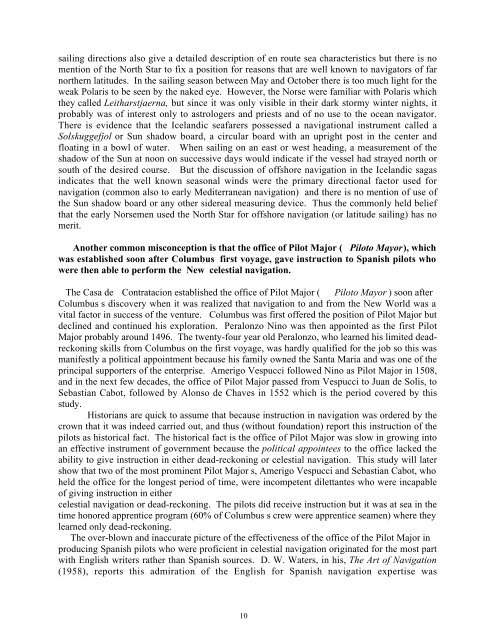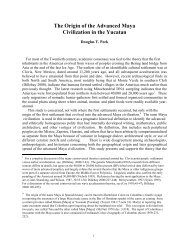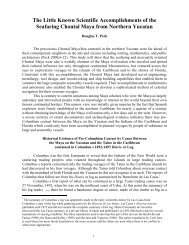The History of Early Dead Reckoning and - New World Explorers
The History of Early Dead Reckoning and - New World Explorers
The History of Early Dead Reckoning and - New World Explorers
Create successful ePaper yourself
Turn your PDF publications into a flip-book with our unique Google optimized e-Paper software.
sailing directions also give a detailed description <strong>of</strong> en route sea characteristics but there is no<br />
mention <strong>of</strong> the North Star to fix a position for reasons that are well known to navigators <strong>of</strong> far<br />
northern latitudes. In the sailing season between May <strong>and</strong> October there is too much light for the<br />
weak Polaris to be seen by the naked eye. However, the Norse were familiar with Polaris which<br />
they called Leitharstjaerna, but since it was only visible in their dark stormy winter nights, it<br />
probably was <strong>of</strong> interest only to astrologers <strong>and</strong> priests <strong>and</strong> <strong>of</strong> no use to the ocean navigator.<br />
<strong>The</strong>re is evidence that the Icel<strong>and</strong>ic seafarers possessed a navigational instrument called a<br />
Solskuggefjol or Sun shadow board, a circular board with an upright post in the center <strong>and</strong><br />
floating in a bowl <strong>of</strong> water. When sailing on an east or west heading, a measurement <strong>of</strong> the<br />
shadow <strong>of</strong> the Sun at noon on successive days would indicate if the vessel had strayed north or<br />
south <strong>of</strong> the desired course. But the discussion <strong>of</strong> <strong>of</strong>fshore navigation in the Icel<strong>and</strong>ic sagas<br />
indicates that the well known seasonal winds were the primary directional factor used for<br />
navigation (common also to early Mediterranean navigation) <strong>and</strong> there is no mention <strong>of</strong> use <strong>of</strong><br />
the Sun shadow board or any other sidereal measuring device. Thus the commonly held belief<br />
that the early Norsemen used the North Star for <strong>of</strong>fshore navigation (or latitude sailing) has no<br />
merit.<br />
Another common misconception is that the <strong>of</strong>fice <strong>of</strong> Pilot Major ( Piloto Mayor), which<br />
was established soon after Columbus first voyage, gave instruction to Spanish pilots who<br />
were then able to perform the <strong>New</strong> celestial navigation.<br />
<strong>The</strong> Casa de Contratacion established the <strong>of</strong>fice <strong>of</strong> Pilot Major ( Piloto Mayor ) soon after<br />
Columbus s discovery when it was realized that navigation to <strong>and</strong> from the <strong>New</strong> <strong>World</strong> was a<br />
vital factor in success <strong>of</strong> the venture. Columbus was first <strong>of</strong>fered the position <strong>of</strong> Pilot Major but<br />
declined <strong>and</strong> continued his exploration. Peralonzo Nino was then appointed as the first Pilot<br />
Major probably around 1496. <strong>The</strong> twenty-four year old Peralonzo, who learned his limited deadreckoning<br />
skills from Columbus on the first voyage, was hardly qualified for the job so this was<br />
manifestly a political appointment because his family owned the Santa Maria <strong>and</strong> was one <strong>of</strong> the<br />
principal supporters <strong>of</strong> the enterprise. Amerigo Vespucci followed Nino as Pilot Major in 1508,<br />
<strong>and</strong> in the next few decades, the <strong>of</strong>fice <strong>of</strong> Pilot Major passed from Vespucci to Juan de Solis, to<br />
Sebastian Cabot, followed by Alonso de Chaves in 1552 which is the period covered by this<br />
study.<br />
Historians are quick to assume that because instruction in navigation was ordered by the<br />
crown that it was indeed carried out, <strong>and</strong> thus (without foundation) report this instruction <strong>of</strong> the<br />
pilots as historical fact. <strong>The</strong> historical fact is the <strong>of</strong>fice <strong>of</strong> Pilot Major was slow in growing into<br />
an effective instrument <strong>of</strong> government because the political appointees to the <strong>of</strong>fice lacked the<br />
ability to give instruction in either dead-reckoning or celestial navigation. This study will later<br />
show that two <strong>of</strong> the most prominent Pilot Major s, Amerigo Vespucci <strong>and</strong> Sebastian Cabot, who<br />
held the <strong>of</strong>fice for the longest period <strong>of</strong> time, were incompetent dilettantes who were incapable<br />
<strong>of</strong> giving instruction in either<br />
celestial navigation or dead-reckoning. <strong>The</strong> pilots did receive instruction but it was at sea in the<br />
time honored apprentice program (60% <strong>of</strong> Columbus s crew were apprentice seamen) where they<br />
learned only dead-reckoning.<br />
<strong>The</strong> over-blown <strong>and</strong> inaccurate picture <strong>of</strong> the effectiveness <strong>of</strong> the <strong>of</strong>fice <strong>of</strong> the Pilot Major in<br />
producing Spanish pilots who were pr<strong>of</strong>icient in celestial navigation originated for the most part<br />
with English writers rather than Spanish sources. D. W. Waters, in his, <strong>The</strong> Art <strong>of</strong> Navigation<br />
(1958), reports this admiration <strong>of</strong> the English for Spanish navigation expertise was<br />
10





